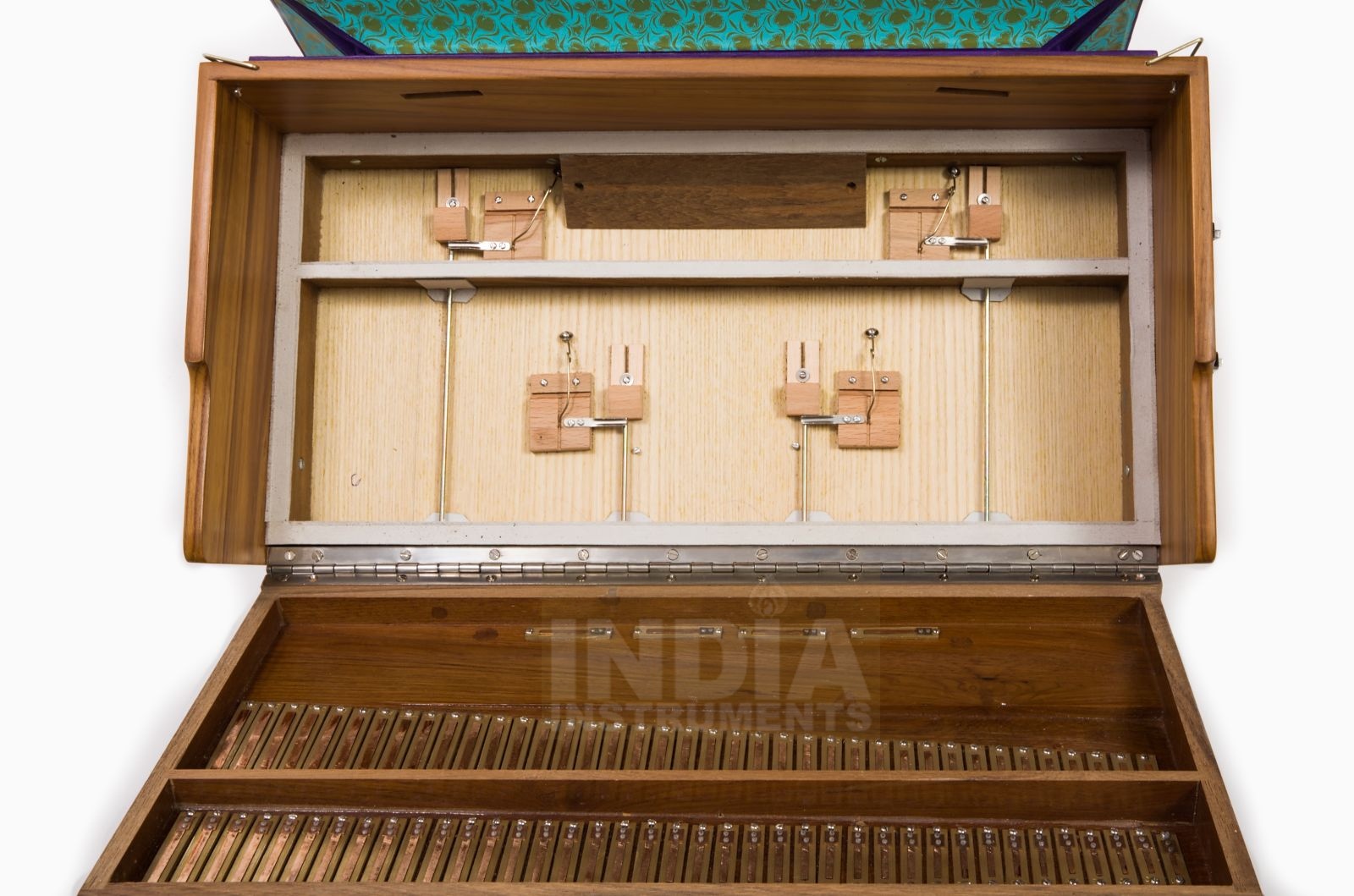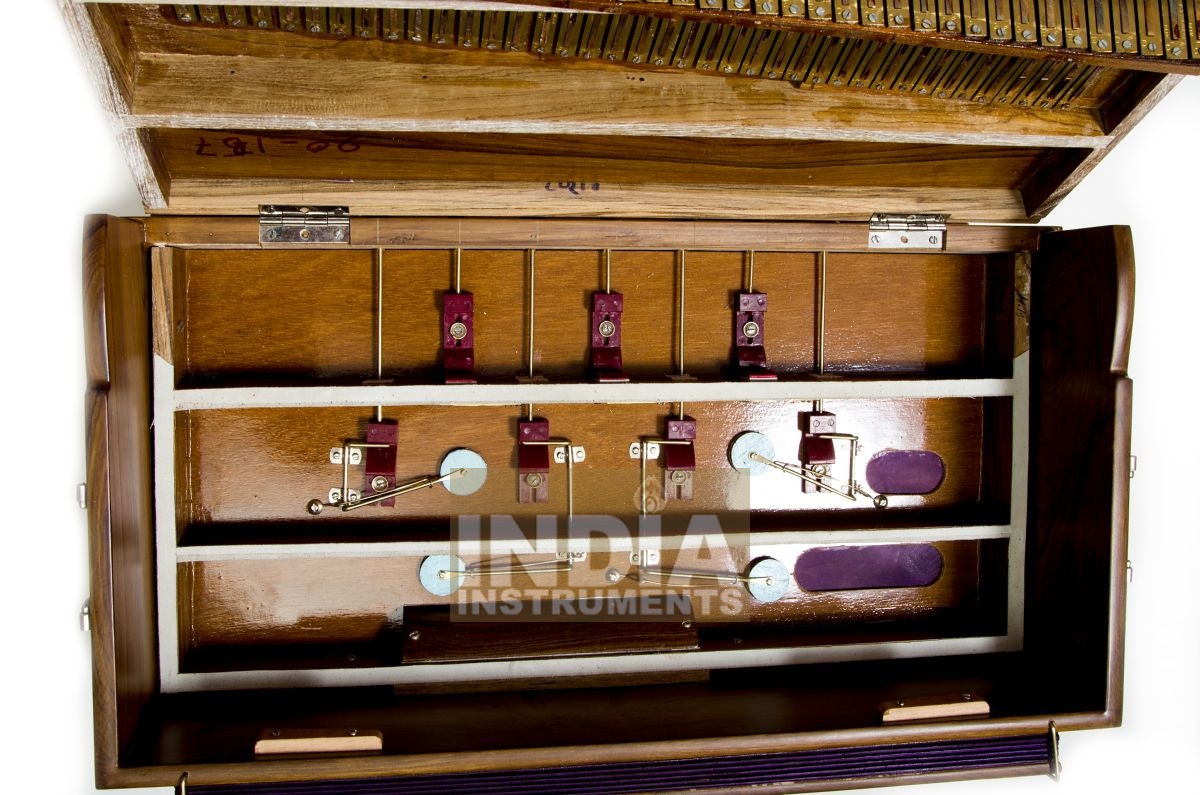Harmonium Purchase Guide
India Instruments offers a wide range of different harmonium models. The Harmonium Purchase Guide gives you comprehensive information about seven essential topics:
Sound is the essence of any musical instrument. The instrument speaks to you with its sound. All other purchase criteria are ultimately secondary. Only when you really like the sound of a harmonium, when it pleases your ears, touches your heart, and you feel carried by it, will you be inspired to play it as much as possible. And only when you play your harmonium as much as possible you develop a deep connection, so that you become more and more familiar and free with it.
However, personal tonal preferences differ considerably. What some people describe as warm and soft or brilliant and bright may seem muffled and dull or sharp and shrill to others. THE good sound as such does not exist. Only YOU can decide which sound appeals to you and touches you most.
Sometimes it's easy to find out your personal sound preference. You hear a harmonium somewhere and are so enchanted by it, that you immediately know: This is exactly how your harmonium should sound! But sometimes it is a longer process. Maybe you still lack listening experience and you develop your own taste over time by comparative listening. Or you have an idea of the perfect sound in your mind, but you don't find it anywhere in reality. Anyway, ideally you should listen to a harmonium yourself before buying it. That's the only way you can be sure that its sound is appealing and inspiring for you. Recordings are only partially helpful – the required audio technology chain distorts the natural sound too much. And verbal descriptions are far too vague to be reliable. In our shop in Berlin (and at some of our retail partners) you can therefore check out harmoniums to your heart's content - we have (almost) always a wide range of different harmoniums in stock for testing and comparing. Maybe you can also try a harmonium of a friend, or in a harmonium workshop or during a mantra singing event. The more listening experience you get, the better you will know what you want.
After the sound, the feel is the most important criterion in choosing a harmonium. Can you sit comfortably with the instrument? Can you pump the bellows with a simple natural movement? How do the keys react to your touch? The texture of the surfaces and the instrument's look can also matter. You will only look forward to playing your harmonium when you're at ease with it. The feel, just like the sound, can not really be represented in an online shop. You need to experience it yourself, hands on with your prospective harmonium. And only YOU can decide which instrument feels good and which one doesn't. The feel is another strong argument for getting your harmonium where you can directly compare several different models with one another.
What do you want to do with your harmonium? What features should it have? Clarity about these questions helps you choose the right model. Decisive for the musical possibilities of a harmonium are the number and type of reed sets, register separation, range, drones and the additional features octave coupler and scale changer.
There are harmonium reeds in three registers, each an octave apart: bass is for low tones, male for medium tones and female for high tones. By default, the majority of harmoniums have two sets of reeds, usually bass and male. Bass provides warmth while male gives clarity to the sound.
Two reed sets Bass-Male horizontal in separate register chambers
Harmoniums with three sets of reeds, usually in the combination bass-male-female, offer a particularly wide range of musical possibilities. The additional female reeds give the sound radiance and brilliance and improve audibility with their high frequencies, e.g. when singing with large groups or in instrumental ensembles. 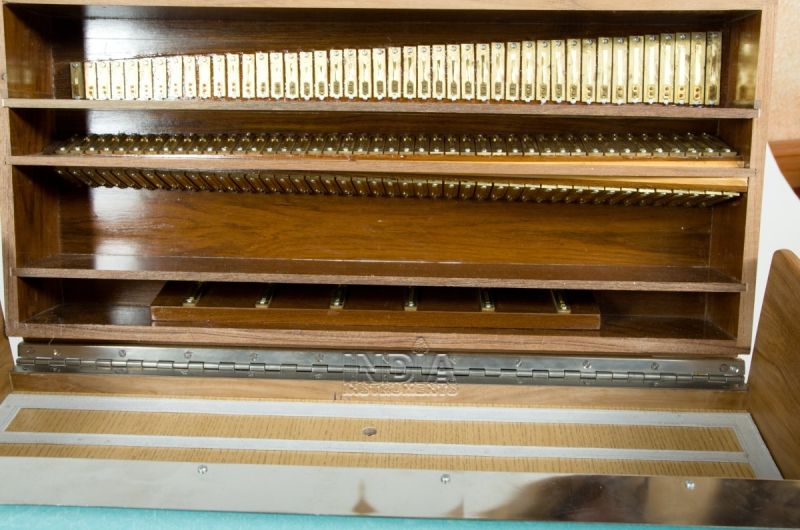
Three sets of reeds in separate register chambers: Bass-Male vertical, Female horizontal
Harmoniums with only one set of reeds are unusual and are mainly used for learning or practice. They lack the sonority of two octaves vibrating together. However, they can be useful as particularly small, light and robust companions for travelling.
Normally, each set of reeds sits in its own airtight register chamber. The register knobs at the front of the harmonium are fixed onto pull rods that move air flaps inside the register chambers. When you pull out a register knob, you open an air flap in the associated register chamber and allow the air to flow in and make the reeds sound. On harmoniums with two sets of reeds, you can use the register knobs to set whether only the bass reeds, only the male reeds or both male and bass together should sound. With three sets of reeds, you can combine all three registers in any way you like, giving you seven different ways of adjusting the sound. This is a great advantage if you appreciate a very flexible sound.
Two register chambers, each with two slides with air flaps; at the front/top in the picture three drone slides.
Models without register knobs, e.g. our Compactina, Harinam or Basic harmoniums, have all reeds together in a single air chamber. Therefore the male and bass reeds cannot be played separately - they always sound together. The lack of register separation has an advantage, though: it makes the harmonium lighter and more robust.
Most harmoniums have not only register knobs but also drone knobs at the front. Drone knobs are often a little smaller or in a different colour or in a separate row. If you pull out a drone knob (and the register chamber in which the drone reeds are located is open), you get a continuous tone without pressing any key when you pump the bellows. Often you can combine two drones for a richer sound. This can support you wonderfully when playing modal melodies or singing simple chants. For vocal accompaniment with changing chords, however, you don't need drones.
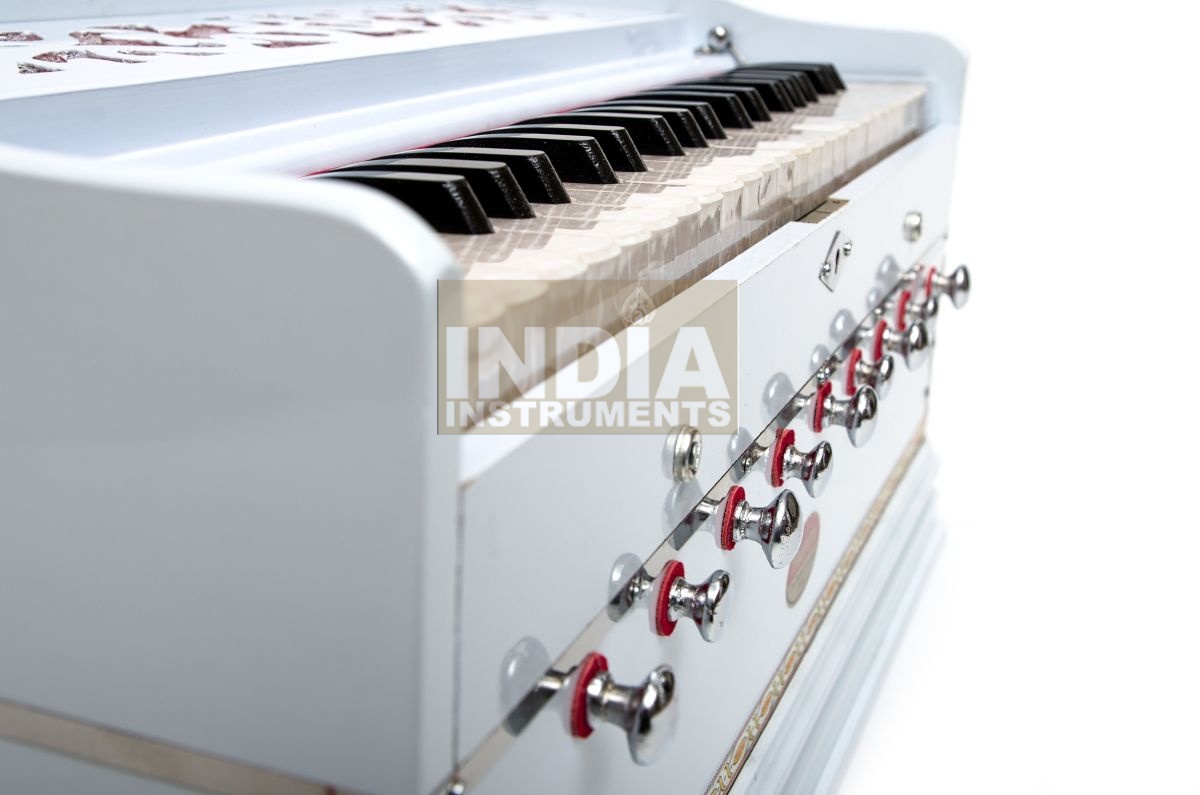
Five register knobs with four smaller drone knobs between them
Standard harmoniums have a range of 3 ¼ to 3 ½ octaves.
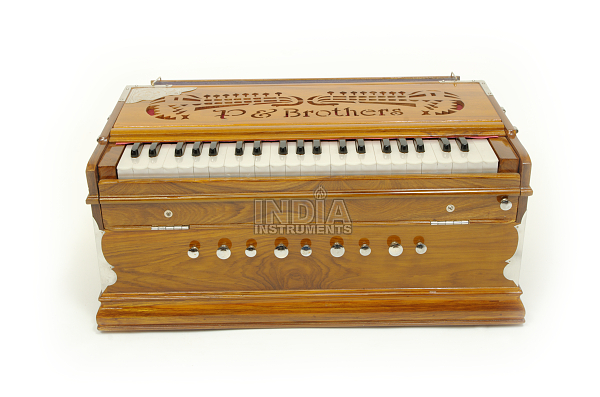 Range 3 ½ octaves
Range 3 ½ octaves
Models with less range are smaller and lighter and therefore easier to transport.

Range 2 ¼ octaves
The reduced range, however, limits the musical possibilities and often results in less sustain, because smaller harmoniums have less air capacity available. If, however, you already know for sure in which range and style you want to play, a smaller range can be just right.
Octave couplers are simple mechanisms that activate an additional note one octave apart from the key that you press. The note played is doubled, so to speak. This mechanism can be switched on or off as required. There are two different types of octave couplers that cannot both be built into one harmonium together. Lower octave couplers give the sound warmth, impact and mass.

Lower octave coupler lever
Higher octave couplers give the sound radiance, brilliance and sharpness.
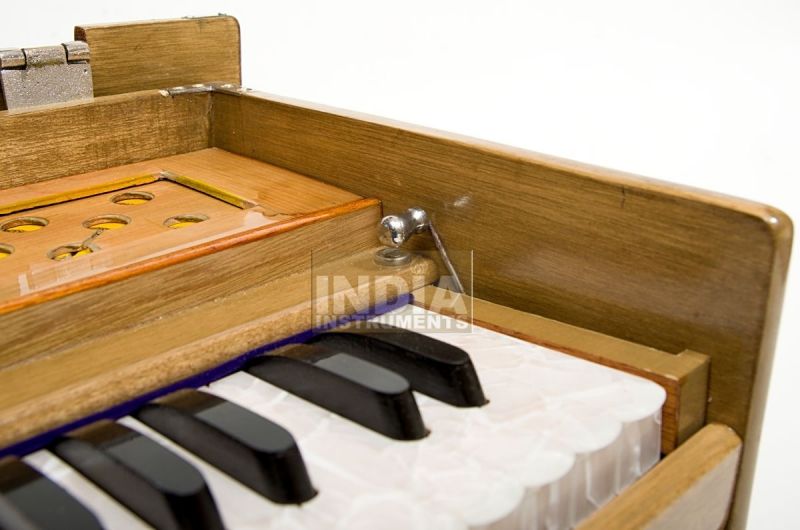
Higher octave coupler lever
In any case, an octave coupler significantly expands the musical possibilities. On a harmonium with three sets of reeds, up to six reeds can be played simultaneously with one key, resulting in an almost orchestral sound. When they are active, however, the octave couplers also lead to higher air consumption, which can impair the sustain. Another downside: octave couplers are additional components that make the instrument slightly heavier and more sensitive.
The scale changer is a mechanism that allows the entire keyboard to be shifted in semitone steps, thus changing the sounding pitch of the keys. This allows you to switch from one key to another in no time without having to change your fingering. If you are musically proficient and can transpose easily, this is not relevant though. But if you don't have thorough musical training and you have to play occaisonally in different keys (e. g. because you accompany different vocal groups), the scale changer is a very helpful tool. Scale changers are also additional components that make the instrument a little heavier, more expensive and more sensitive.
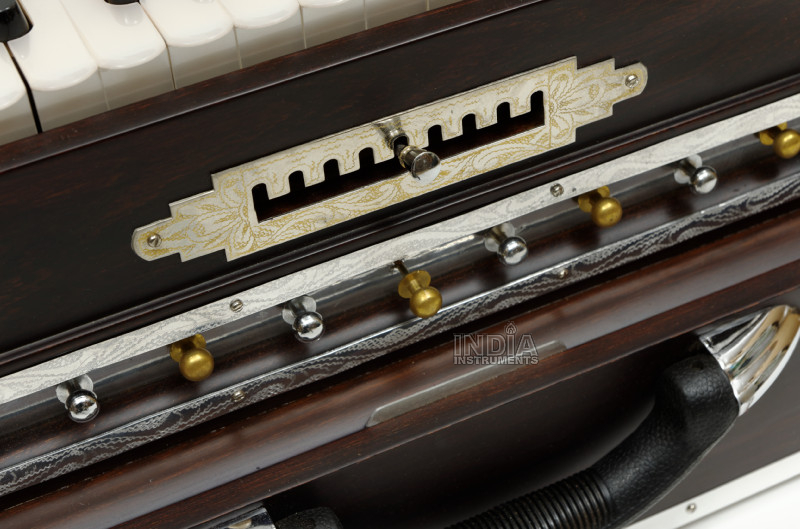
Lever for scale changer key selection
There are three common designs for harmonium keys. All have white and black key surfaces at the visible front end and thin pieces of leather at bottom side of the rear end, under the removable cover plate (jali), to seal the air channels over the reeds.
Stick keys consist of a continuous piece of wood with a small hole in the middle and a notch at the back end. The middle hole is stuck on a vertical thin nail and is the pivot point of the key. In the back notch is another thin vertical nail that holds the key on its axis. A spring presses on the back end so that the key does not open by itself. Stick keys are the simplest and cheapest type of construction and common standard on harmoniums from Delhi and the Indian Northwest. They sometimes tend to make slight noises or jam when played, e.g. when they are not crafted with utmost precision, when the long wooden stick warps a little, or when the nails in the notch or the pivot are crooked or set slightly out of centre..

Stick keys
Stick palette keys have a thin nail set crosswise horizontally in the middle as the pivot point and are therefore very well centred. At the rear end, the stick is shortened and a palette with the leather seals is attached. The distance between the key stick and the palette can be changed with a screw. This way you can always set an exactly equal height of all keys at the front. The palette always lifts exactly vertically from the air holes when the key is pressed, so that there is an even air flow in all registers. Stick palette keys are also called English keys or French keys.
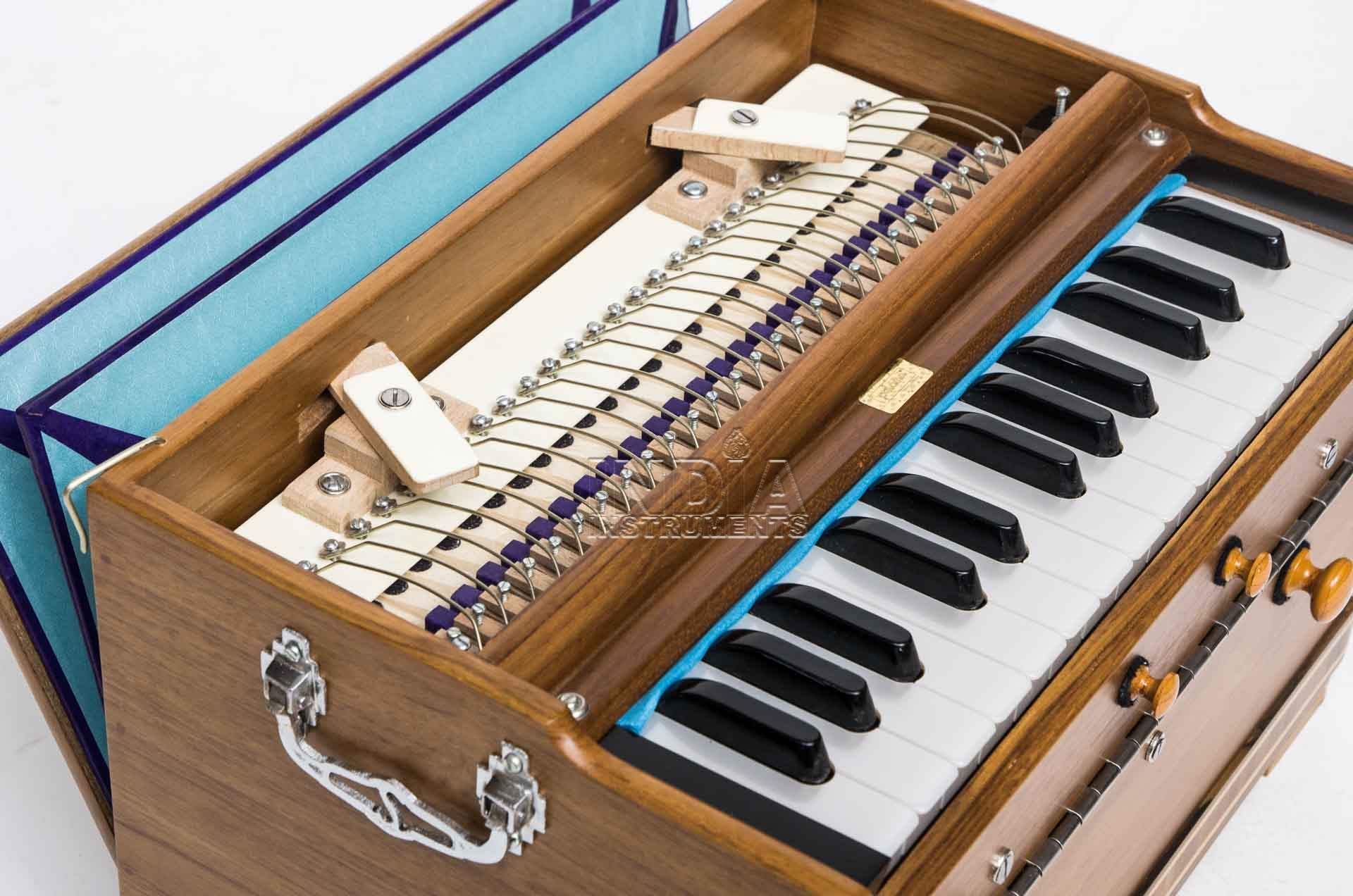
Stick palette keys
Stick lever palette keys are similar to the stick palette keys. However, they are divided into three parts and have the palettes with the seals on a separate lever, which is lifted upwards by the key stick when the key is pressed. This particularly elaborate construction is necessary for harmoniums with scale changers and with lower octave couplers.
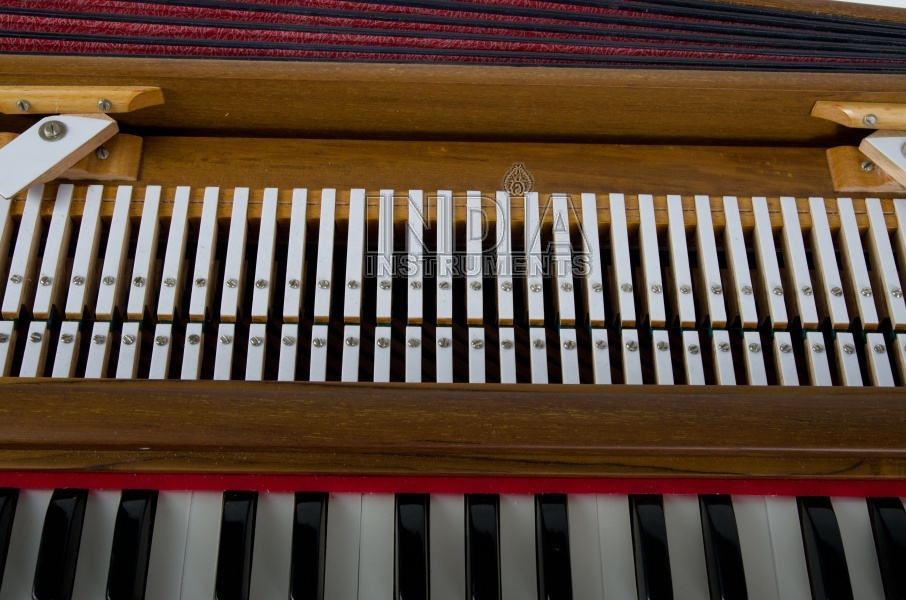
Stick lever palette keys
The outer bellows for the air supply can open either at the top or at the side. You can decide which is more comfortable for you according to your own feeling. It doesn't make a difference for the air supply whether the bellows opens at the top or at the side.
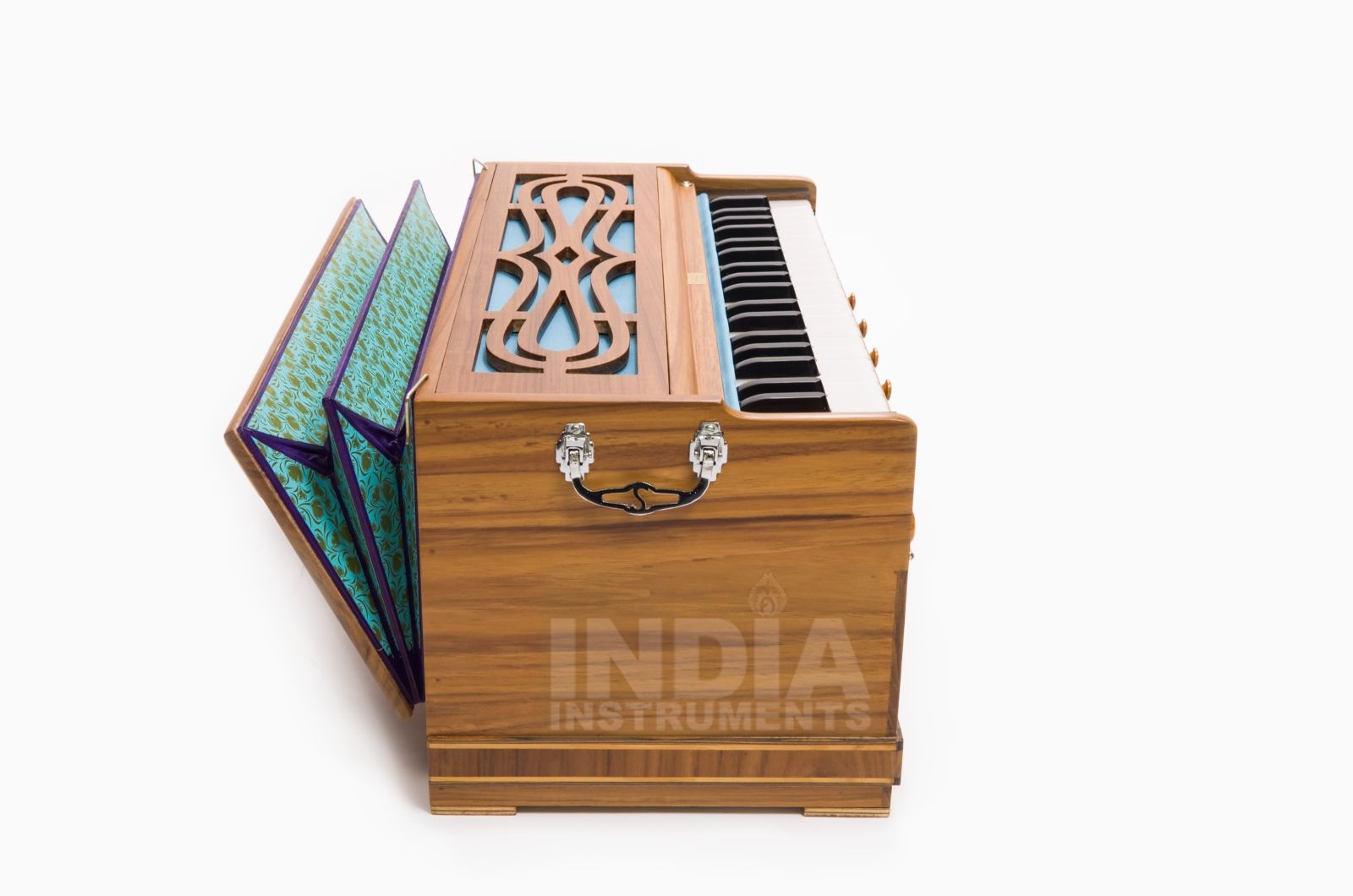
Top opening bellows
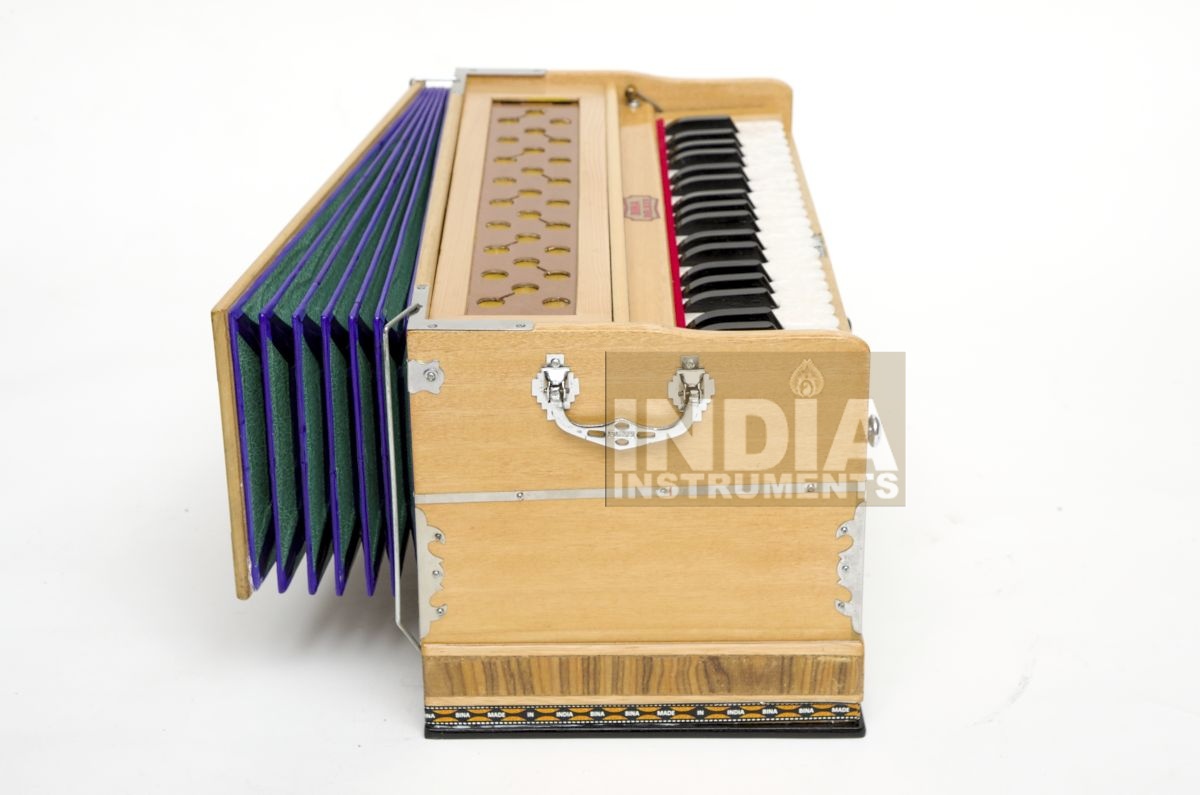
Side-opening bellows
Most bellows have a spring inside that opens them automatically when you release the latch. This is convenient because you don't have to actively open the bellows. The downside: you always push against the resistance of the spring when you pump. When you have gained experience with the harmonium and want to adjust the air supply yourself, the built-in spring can be removed quite easily. Conversely, a spring can also be inserted into the bellows quite easily if you are missing it.
The cabinet of most harmoniums is made of either teak or softwood. Teak is mainly used in Kolkata and Mumbai. It is very hard, robust, dimensionally stable and durable, but also somewhat heavier and more expensive. It usually has a beautiful, vivid grain, which is why teak harmoniums are often only given a transparent varnish.
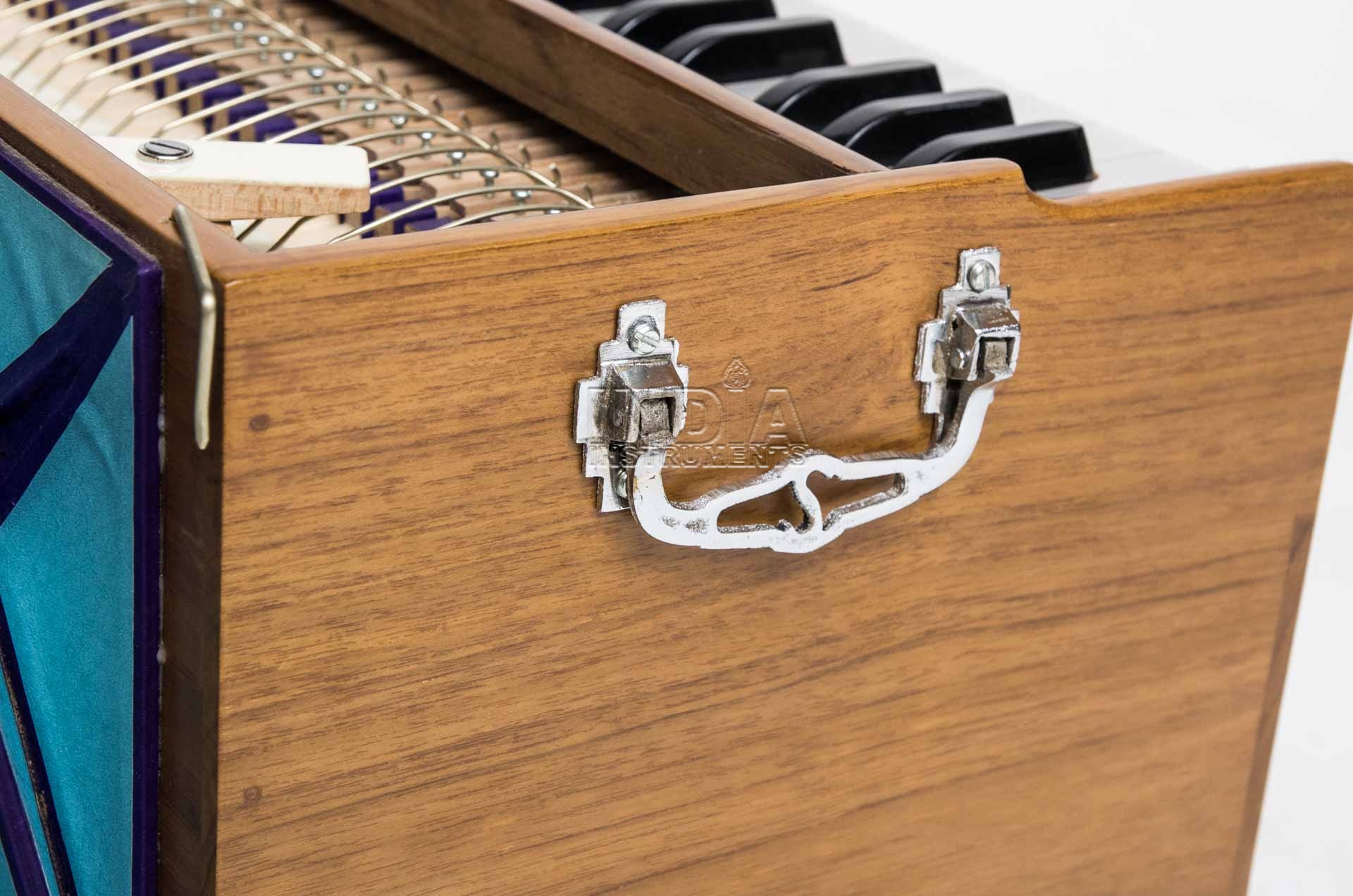
Teakwood natural
Softwood is mainly used by harmonium makers in Delhi and the Indian Northwest. It is relatively cheap and light, but it also gets scratches and dents easily and can warp due to fluctuating humidity. With softwood harmoniums, pigments are usually added to the varnish so that the grain is no longer visible. In this way, different colours can be offered - but flaws in the wood can also be concealed.
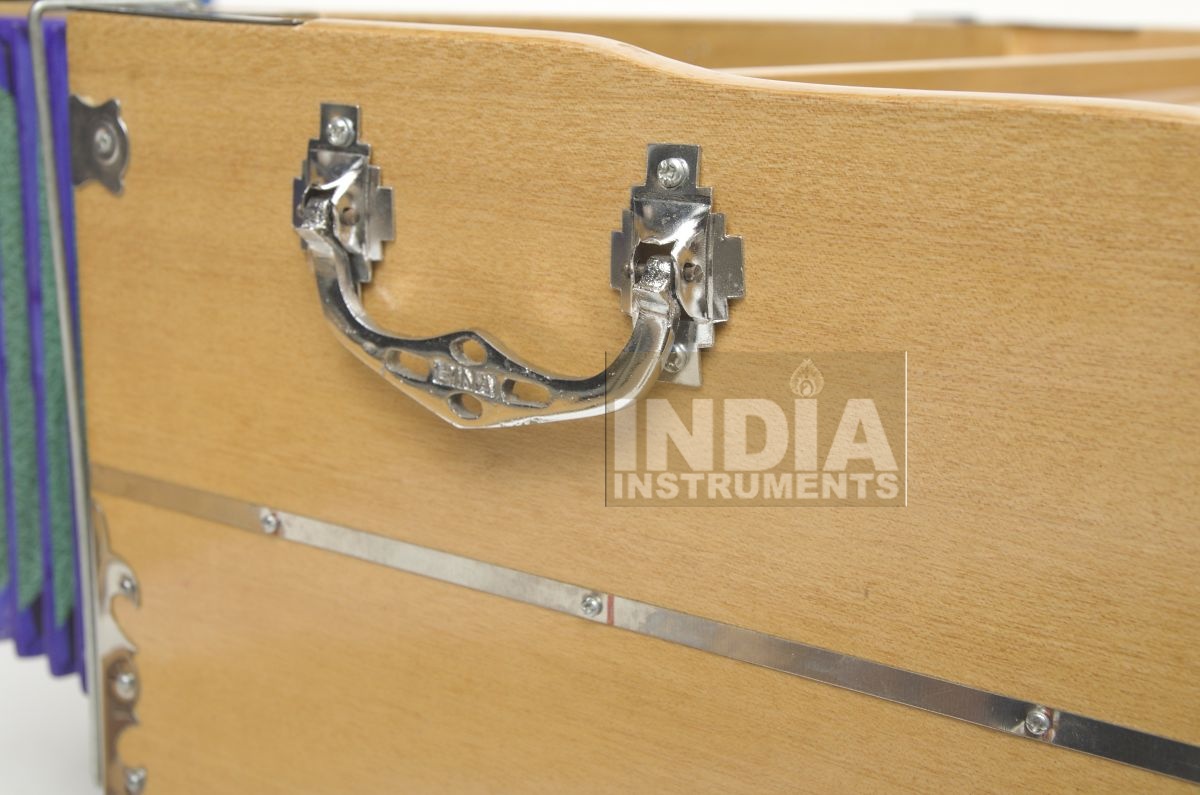
Softwood natural
Ideally, all notes of a harmonium should respond immediately and evenly loudly, should continue to sound evenly for as long as possible without constant pumping, and it should be possible to modify the volume by pumping more or less vigorously. However, these requirements are sometimes contradictory and therefore cannot all be realised in the same way. Therefore, the interaction of the vibrating reeds and the air pressure with which they are blown must be sensibly coordinated for the desired style of playing. In classical Indian music, for example, the reeds should respond quickly and powerfully and not reverberate for a long time. In this way, the many delicate ornaments and precise rhythmic accents with which Indian melodies are performed come into their own right. For Western vocal accompaniment with chords, on the other hand, the reeds should respond softly and sustain the sound for a longer time.
The blowing pressure has the greatest influence on sustain, response and volume. On most harmoniums, the blowing bellows are not visible from the outside and are located at the bottom of the cabinet, below the keyboard and air chambers. When not in use, strong springs on the base plate of the harmonium keep the inner bellows compressed. But when it is filled with air by pumping, the bottom springs want to push the air out again. Depending on their tension, the springs exert a certain pressure. When the pressure is high, the reeds respond immediately and very loudly and have very little sustain - this is the Indian melody style. When the pressure is lower, the reeds respond more softly, possibly with a slight delay, and have a longer sustain - this is the Western chord style. The spring tension can be changed relatively easily by bending and possibly shortening the springs. That is why sustain, response and volume can be adjusted according to individual preferences in specialised workshops - within certain limits. By default, our harmoniums are set rather soft, with longer sustain, medium volume and slow fade out of the notes.
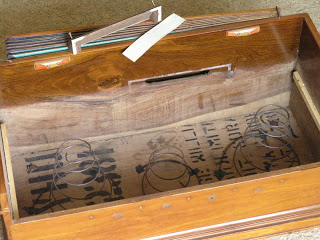
Three springs on the base plate of a harmonium cabinet
On harmoniums with a relatively small bellows, however, the possibilities of adjusting the blowing pressure are limited, because there is simply not enough air capacity available. Especially extended chords with three or more notes at the same time are hard to play without volume fluctuations on harmoniums with small bellows. This is especially true for harmoniums with a range of less than three octaves or with visible bellows in the shape of a prism instead of a cuboid, as is the case with our Compactina and Harinam models. So be prepared for limited sustain and pretty active and careful pumping if you are looking for a particularly small and light harmonium for travelling.
When the spring tension is set as desired, individual notes may respond with delay or sound softer than others or muffled. In that case the manufacturer has poorly adjusted the respective reeds or they have become deformed due to intensive play or external influences. To solve this problem, the affected reeds must be bent into proper shape. A few bad notes in an otherwise good harmonium can be fixed relatively well like that. This work needs a lot of experience and sensitivity though.
Conclusion: Although sustain, response and volume are very important for the feeling when you playing, they can be relatively well adjusted to individual preferences. Therefore, they should not play too big a role in the choice of a harmonium - even if some advisors see it differently. Much more important for a purchase decision should be elements that cannot be changed so easily. Only in the case of particularly small or compact harmoniums should restrictions be taken into account.
If you want to travel a lot with a harmonium, you need an instrument that is light, small and robust and at the same time does not have any musical restrictions. However, such a perfect travel harmonium has not yet been invented. The smaller and lighter the instrument, the bigger the musical limitations. Therefore you need to define personal priorities and make smart practical compromises when choosing a harmonium for frequent travels.
It is advisable that you can carry your harmonium on the road with one hand. Whether it weighs 6 kg or 12 or even 18 makes a big difference. Weight can be saved in different ways. Without movable keyboard (scale changer), octave coupler, register separation, folding mechanism or a third reed set you get a lighter instrument with less components. A harmonium can also be built smaller altogether. As a result, you lose tonal range, but that usually does not matter for singing accompaniment. More critical is the smaller air capacity, since this can hamper the sustain. Another way to reduce weight is the vertical construction of Compactina harmoniums - the heavy wooden outer cabinet is not needed here. Unfortunately their air capacity is also smaller than that of regular harmoniums. On the other hand, the bellows springs are easily accessible and can be used to adapt the sustain to your requirements to some extent.
The smaller a harmonium, the easier it can be stored on the way. Depending on your general baggage and transportation situation, this can be an important factor. Many models therefore have a mechanism that folds them into an integrated wooden box. This reduces the packing size considerably. However, most of the folding mechanisms are somewhat cumbersome to handle, and together with the integrated case they also make the instrument heavier. As an alternative, harmoniums can be made smaller altogether or without wooden frame (see above), resulting in smaller dimensions without additional weight and folding hassle
On the road, a harmonium is almost inevitably shaken and exposed to fluctuations in temperature and humidity. Therefore it should be pretty sturdy. That is why a harmonium that is well suited for travelling should be as simple as possible - after all, every component can warp, shift, wear out or otherwise break down over time. This is also an argument against extras with lots of small moveable parts such as octave coupler and scale changer. At least equally important is the quality of material and workmanship. Teakwood is basically harder and less sensitive to climate changes than softwood. However, all wooden parts must also be well seasoned so they do not warp or crack during later drying. And the best materials are of little use when they are not fitted meticulously. This takes time and requires special skills. All-round good quality in materials and manufacturing is therefore usually directly reflected by the price.
When you buy a new harmonium today, it is usually tuned to standard pitch a' with 440 hertz in equal temperament. What does that mean? Hertz is the physical unit for pitches. It tells you how often a tone oscillates per second. More hertz means that a tone sounds higher, and with less hertz it sounds lower. Standard pitch means the frequency according to which tuning takes place, i.e. it is the benchmark for all other tones. In case of a' (A4 in scientific writing) 440 hertz tuning, the a' oscillates 440 times per second. Temperament means that the intervals of the natural tones of the overtone series are altered according to specific musical requirements. Equal temperament means that all semtone intervals have the same uniform ratio. This allows you to switch at will between all possible keys.
Standard pitches are a pragmatic invention of classical Western music. Over time, instrumental ensembles grew in size and needed a common reference tone to play together. This was called a concert pitch, and for centuries it was determined according to region, musical style and ensemble. It was not until the 18th century that efforts to establish a standard began, as it was now possible to define pitches precisely with tuning forks and musical life became increasingly international. Throughout the 19th century a variety of very different standard pitches were still in use. While in France, for example, the a' was legally fixed at 435 hertz, in England music was predominantly played at 452 hertz. It was not until the 20th century that an international standard of 440 hertz was agreed upon. However, this standard is not binding - leading orchestras as well as early music ensembles, for example, deliberately still use different standard pitches today.
Indian music tradition has no need for any uniform standard pitch. The fundamental of an ensemble is always determined by the leader at his/her own discretion - just as it used to be in early Western music. But although harmoniums are built in India, their construction and tone production with fixed pitches is based on 19th century Western concepts. In the British colonial period, they were therefore mostly tuned to the high English concert pitch of 452 hertz. It was only with the increasing demand in the West from the late 20th century onwards (and the invention of digital tuners and tuning apps) that most Indian reed factories and harmonium makers switched to the 440 hertz standard. The great advantages of equal temperament 440 hertz tuning are its widespread use and its flexibility. You can play together with the vast majority of other contemporary instruments - and you can switch between all possible keys at will.
Tuning to a different concert pitch or with a different temperament limits the flexibility considerably. But it can also have very special artistic, therapeutic or meditative effects. Some people, for example, find a much lower tuning to 432 hertz softer and more relaxing or consider it fundamentally more natural, harmonious and healing. However, the reeds for harmoniums and shrutiboxes are nowadays only produced in 440 hertz tuning. Therefore, harmoniums and shrutiboxes have to be retuned to 432 hertz by hand. To do this, the reed bases must be softened by scraping away material and thus slow down the vibrations. However, removing material from the reed bases reduces their stability and makes them more prone to breaking or getting out of tune. It can also reduce the resale value if you want to part with your harmonium at some point. You are welcome to commission custom tunings at India Instruments. However, we recommend this only if you are pretty experienced and know exactly what you want to do with the harmonium. If you are interested, please contact us for advice.
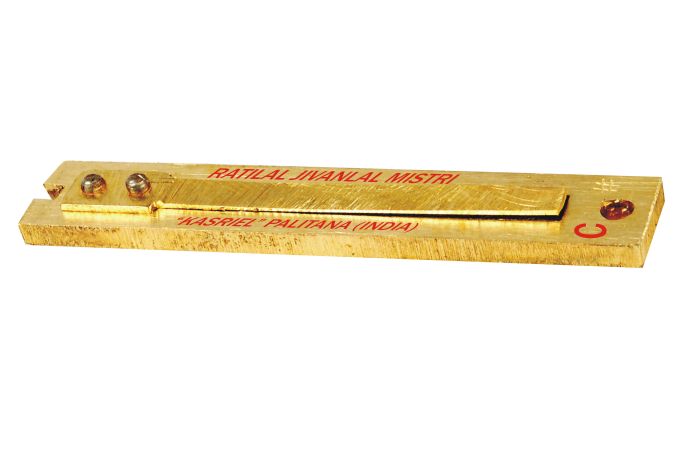
Indian harmonium reed in C by Ratilal Jivanlal Mistri
Finally some practical physics, auditory psychology and recording studio technology... The exact frequency of harmonium reeds depends on the air temperature. When a harmonium has been tuned to 440 hertz in India at 30 degrees centigrade, then it sounds about one to two hertz higher when measured in Europe at 20 degrees centigrade room temperature. That's because the metal reeds become slightly more stiff due to the lower temperature and thus vibrate faster once they are activated. However, our ears usually don't notice such fine deviations without special training. The pitch can change very noticeably due to excessive pumping, though. Excessive pumping leads to overpressure inside the instrument, which inhibits the vibrations of the reeds and thus lowers the pitch. You can hear such pitch sagging due to overpressure most clearly in the lowest notes. But when you record a harmonium in a well-equipped studio, you don't have to worry: When the harmonium has been recorded separately, state of the art audio technology can simply adjust deviations from the desired pitch afterwards.
Where do you get your harmonium when you know, which kind of model you want? If you are lucky, there is an established retailer in your area, who imports directly from India and who has your favourite amongst many different harmonium models in stock. There you can compare various instruments, have everything checked thoroughly and take home your instrument of choice. Ideally, such a retailer has his/her own workshop for tuning harmoniums, fixing air leaks, making stuck parts move or repair damaged wood parts. This way you can come back if something breaks or maintenance is due after long periods of use.
If there is no retailer available nearby, the next best possibility is to travel to one elsewhere. Maybe you can find a retailer you can reach to and get back from within a day, or in a city where you go regularly anyway. The additional effort in time and travelling cost is usually worth it. Harmoniums are just not uniform industrial mass products, but are handcrafted individually in small series.
If you can not make it to a retailer, you can order via the internet. Even though the whole world is at your disposal here, the abundance of offers is hard to assess. For orientation it can be helpful to ask someone with more experience for an online shop recommendation, e.g. a harmonium teacher whom you had lessons or workshops with, or a friend who has already bought a harmonium online. When viewing an online shop, make sure that there is comprehensive info on each harmonium model in description, technical details, pictures and sound samples. Check the origin of the instruments (manufacturer? brand? no-name?), the rules for guarantee and cancellation, as well as to the credibility, experience and competence of the shop owner. A good retailer will shows his/her name, face, bio data and contact details, has been in the instrument business for many years and does repairs on his/her own.
If you compare offers online, you will find various dealers in Europe and North America with roughly similar price levels. With a dealer in the European Union (EU) you don't run any risk. EU law grants you the right of revoking any online purchase within 14 days after receiving the instrument - if you don‘t like the ordered harmonium you can simply return it without giving any reason. However, you can save yourself the shipping cost and hassle of returning a harmonium if you already know which model you would like. And if you are unsure about your choice, a good dealer will be happy to help you find the most suitable model with competent advice. The great advantage of online shipping: you can try out the sound and feel of the instrument at home for up to two weeks. You don't have this much time in a shop. And maybe you just need a few days to relate to the new harmonium and to find out if it's really meant to become YOUR harmonium...
On the internet, you can also find dealers who ship directly from India for half the European prices or even less. With some luck an online purchase in India can be a bargain. But you could as well get into lots of trouble and lose quite a bit of money. When you think about buying in India, you should therefore consider the following points:
* It can easily come to misunderstandings with Indian online dealers because of language barriers and very different cultural conventions.
* Shipping costs are often quite substantial and are not always indicated clearly .
* You normally have to pay value added tax when you import things from overseas into your country. VAT is added to the price of the harmonium plus shipping cost. The apparent price advantage thus gets noticeably smaller.
* Indian online dealers mostly offer no-name instruments with unclear origin. A reliable level of quality is not secured like this.
* Indian online dealers are not necessarily specialists in musical instruments. Some are pure export entrepreneurs who sell all kinds of products and can neither give competent advice nor properly assess the quality of their instruments themselves.
* European quality standards can not be enforced in Indian handicraft production. You always have to be prepared for flaws like unbalanced tuning, jammed keys, buzzing reeds, missing register separation, air leaks, loose screws, scratches and dents. Leaving such flaws as they are can spoil all fun with the instrument – and getting them fixed outside India can cost a lot of time, money and nerves.
* In the case of major defects or transport damage, which can always occur due to inadequate packaging or poor handling en route, you are dependent on the goodwill of the dealer. Once you have paid in advance, you can hardly enforce justified claims in case of conflict.
* If the delivered instrument is different from how it was portrayed online or from your expectations, you also depend on the goodwill of the dealer.
* Your costs for money transfer, shipping, customs clearance and VAT are usually lost in case of problems, even if you get the purchase price of the instrument refunded.
* Online security is rather neglected in India. We know of cases, in which hackers diverted money transfers meant for Indian online dealers to their own bank accounts, by manipulating emails. The money of the buyers was lost and the dealers rejected any responsibility.
Of course you can carry a harmonium from India yourself. But it is not that easy to find good quality, especially when your time is limited. And when you have found a beautiful instrument you have to get it home safely as well. If you already have hand baggage and a suitcase, you can not just add a harmonium to your luggage. For shipping you need secure packaging and have to handle several formalities. That, too, can take a surprising amount of time, money and nerves.
Buying a used harmonium from a private seller is always a gamble. Especially if you buy online, without having checked and tested it thoroughly beforehand. It is rather common that several notes are out of tune. Of course, you can have them tuned later, but that takes time and additional money. Serious problems arise when there are hidden damages in the structure. Air leaks caused by warped or cracked wooden panels can make it impossible to produce the required air pressure for proper sound production. This can make a harmonium completely unplayable. With a second hand harmonium you are only on the safe side, when you buy it from a specialist dealer with a comprehensive guarantee.
We have now reached the end of our Harmonium Purchase Guide. We hope it has given you a comprehensive orientation about all major issues. Please write to us at music@india-instruments.com if you find anything missing or unclear, or if you would like to share your experience of buying a harmonium!
To our harmonium overview.
